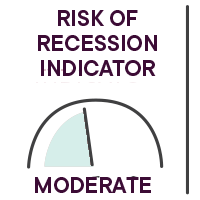Yann Furic
B.B.A., M. Sc., CFA®
Senior Portfolio Manager, Asset Allocation and Alternative Strategies
What moved the markets:
No policy rate increase in Canada
Economy still robust in the United States
Employment growth in the United States and Canada

|
OVERVIEW OF GLOBAL EQUITY MARKETS |
||||
|
Country |
Index |
Return |
Change |
Year-to-date return |
|
Canada |
S&P/TSX |
-1.37% |
|
6.94% |
|
United States |
S&P 500 |
1.15% |
|
18.55% |
|
|
Nasdaq |
0.68% |
|
34.69% |
|
International stock markets |
EAFE |
-1.15% |
|
10.70% |
|
Emerging markets |
|
-3.54% |
|
4.40% |
|
China |
MSCI China |
-6.42% |
|
-4.80% |
Results – Canadian bonds
The FTSE Canada Universe Bond Index has posted a positive return of 1.19% year to date (at August 31, 2023).
*All percentages are in Canadian dollars.
Source : Morningstar Direct.
Our analysis of events

Monetary policy effects
On September 6, the Bank of Canada decided not to increase its policy rate, but it is not closing the door to future rate hikes. Viewed positively, the Canadian economy is slowing and the job market appears to be stabilizing. More negative aspect: inflation is slow to come down and the price of oil has returned to its peak of last November.
The next Fed meeting will take place on September 20 and the market does not expect an announcement of a new rate increase at that time. Note that the U.S. market anticipates three to four rate cuts of 0.25% in 2024.
In order to support central bank policies in the fight against inflation, governments must eschew expansionary fiscal policies. They must limit the growth of their spending and only use targeted programs when necessary. Measures stimulating consumption such as sending cheques to citizens reduces the effectiveness of rate increases and extends the duration of monetary policies.
Employment situation in the United States and Canada
In the United States, August job creation data still show signs of growth, but also an increase in the unemployment rate. This is due to a higher labour force participation rate than last month. In addition, hourly wage growth was below expectations. Slowing wage inflation still remains one of the objectives of the U.S. central bank.
The creation of 39,900 jobs in Canada in August was higher than the 20,000 forecast. The unemployment rate remained stable at 5.5% and the participation rate declined slightly to 65.5%. Hourly wages for permanent jobs were up 5.2% year-over-year, which beat expectations as well as the previous month’s wage level. Note that nearly 50,000 self-employed jobs were created. This figure remains volatile from month to month, with a loss of nearly 40,000 self-employment jobs just four months ago.
Resilience of the U.S. economy
The American economy remains robust and even seems to have accelerated in August. If economic growth continues at this strong pace and if inflation declines to the 2% target, the United States will find itself in a better position than China, which has been hard hit by, among other things, the difficulties of its major real estate developers, a high youth unemployment rate and slower manufacturing growth in Europe, mainly in Germany.
The better relative growth of the United States is reflected in a stronger greenback against other currencies, including the Canadian dollar.
It should be noted that the decision of OPEC+ to maintain its production cuts at least for the next three months led to an increase in the price of oil and helped limit the loonie’s decline.
Composition of certain global stock market indices in 2023 and their returns
The stocks that make up the equity indices and their respective weighting can have a major impact on the performance of these indices.
For example, as at September 5, 2023, the S&P 500 Index in US dollars is up 18.4% year to date. Note that ten companies alone account for 77% of this return and that these are mainly big technology companies. For the same period, an index composed of these same 500 companies, in which each has equal weighting in the index, generated a return of 6.4%.
Value stocks, which are less expensive, and stocks that are less volatile have underperformed the index year to date. The craze for everything related to artificial intelligence has propelled many technology stocks like Nvidia, which is up 230% and which is now the stock with the fourth highest weighting in the index.
In the Europe, Australasia and Japan (EAFE) region, ten stocks account for almost 25% of the index’s return, including Novo Nordisk with its Ozempic product, which has been the largest contributor since the start of the year.
Economic indicators
Global Purchasing Managers’ Index ![]()
Once again in August, the indices show a difference between the manufacturing economy, which is still slowing, and the services component, which continues to grow but which is decelerating.
In the United States, the manufacturing sector currently accounts for 11% of gross domestic product (GDP), according to official 2021 numbers from the World Bank, whereas in 1997 it accounted for about 16% of GDP. According to the U.S. Bureau of Economic Analysis, this percentage was 25% in 1987. The growing size of the services sector may explain why the U.S. economy continues to grow.
In Canada, according to the World Bank, the manufacturing sector accounted for 9.3% of GDP in 2021, versus 16% in 1997.
Inflation rate ![]()
Inflation is still too high, but some indicators are pointing in the right direction. Container prices and rental price growth in the United States are returning to pre-pandemic levels. The bankruptcy of the trucking company Yellow also heralds a slowdown in this sector.
Benchmark rates in Canada, Europe and the United States ![]()
Interest rates are at a level where, if they remain there for an extended period, they will have a significant impact on household and business spending when loans are renewed.

Our strategic monitoring
We have maintained a cautious approach since the start of the year. This approach has underperformed since it is less concentrated in technology stocks, which have benefited from the enthusiasm for all things artificial intelligence.
We are keeping track of inflation as well as the leading indicators for manufacturing production, the services sector and employment. A deterioration in employment or in the services sector would prompt us to be even more cautious.
A notable improvement in the manufacturing indices combined with a return to an inflation rate of about 2% would be clear signs of an economic recovery, but above all of a possible soft landing for the economy.
Earnings estimates for S&P 500 companies are stabilizing and even up slightly, but valuations remain high.
Caution and risk management remain our priorities.
Our tactical positioning
Tactically, we maintained our position in recent months in U.S. large cap growth stocks, which react positively to stabilizing interest rates, and in stocks with a track record of dividend growth which are more defensive. We continue to favour large cap stocks in developed countries.
Since the Bank of Canada’s policy rate increase in early June, we have taken a position in 10-year Canadian bonds, as we believe that longer-term rates will peak over the next few months and then stabilize or decline.
We increased the weighting of these 10-year Canadian bonds in July and August.
To learn how our funds performed:
View the returns
Main risks
- An overly restrictive monetary policy could cause a major recession or other problems, like the U.S. regional bank crisis.
- High interest rates for an extended period would reduce corporate profits and also seriously dampen household spending.
- The possibility of an episode of stagflation, i.e. anemic economic growth and high inflation, persists. This situation is negative for stock markets.
- The conflict in Ukraine could escalate and spread to other European countries. Grain prices could increase following Russia’s cancellation of the maritime transport agreement in this region and contribute to food inflation.
- There is also a risk that tensions could worsen between China and the United States over Taiwan.
Senior Manager, Asset Allocation and Alternative Strategies
Data source : Bloomberg
The opinions expressed here and on the next page do not necessarily represent the views of Professionals’ Financial. The information contained herein has been obtained from sources deemed reliable, but we do not guarantee the accuracy of this information, and it may be incomplete. The opinions expressed are based upon our analysis and interpretation of this information and are not to be construed as a recommendation. Please consult your Wealth Management Advisor.




















